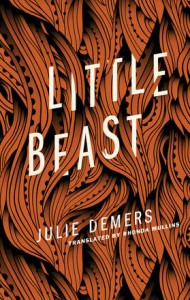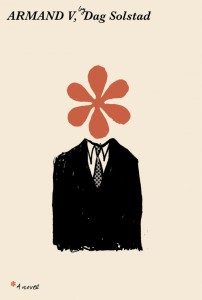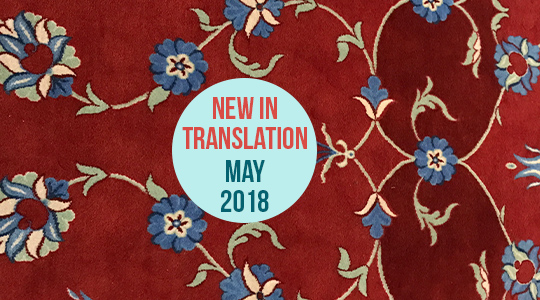The newest issue of Asymptote has just dropped and it is beautiful. In the physical world, the literary world is abuzz with festivals and publications around the world. We are back with another round of the newest and most exciting translation gems coming to bookshelves this month. This month, we bring you reviews of recent publications from Norway and Canada. And if you are looking for even more, carefully selected translations, check out the Asymptote Book Club!

Little Beast by Julie Demers, translated from the French by Rhonda Mullins, Coach House Books, 2018
Reviewed by Emma Page, Communications Manager
Julie Demer’s Little Beast (translated by Rhonda Mullins) is a dark fairy tale, more Grimm than Disney, set in the forbidding landscape of wintery rural Quebec. The shape of the story is familiar. A child, an absent parent, a “curse,” fumbling adults to be outwitted, a quest, a return home. Demers never flinches away from her young narrator’s perspective and yet Little Beast slowly emerges as a tale about the end of childhood and the intersection between experience, self-perception, and cultural narrative.
Our narrator is a young girl who has been ostracized from her village since sprouting a full, bushy beard. The bearded child has been living in an abandoned cabin for a month, foraging for food in and obsessively recording her tale in writing. Running out of fuel in freezing weather, she burns her makeshift home to the ground and sets off in search of a new dwelling. She eventually comes across two hunters with a captive bear, stealing food from them until they spot and capture her. Although at first they are determined to bring her back to the village, they eventually have a change of heart and release her. The child must then make a choice of her own, whether to return to society or disappear into the wilderness for good.
The central “curse” of this fairy tale is the beard, a symbol of virile manhood clinging conspicuously to the face of a young girl. Right from the beginning, sex and the sexes preoccupy the narrator as she begins the story by telling us about 1933:
“That was the year Mother couldn’t stand up without help: pregnancy had her by the jugular. The family had turned their backs on her because she and father had gotten caught up in the ultimate sin. Which is to say, they had touched each other’s difference […] A few months before the due date, she lay down on her back and evicted me like a common tapeworm.”
This is her origin story. An unwanted pregnancy pinning her mother down like a hungry animal. A community where an austere, punishing Christian morality prevails. A failed abortion, or perhaps a miscarriage survived. And that unusual word choice: “difference”. Given the narrator’s age, we understand this is a kind of baby-talk, a euphemism for genitalia that she has not yet outgrown. Like many euphemisms, however, it reveals plenty about what it purports to obscure. In this little town in Gaspesie, sex is the most important “difference” between people, to be emphasized above all else. Being male or female is a calling, a destiny. The narrator recalls her mother’s lessons, in which she is taught that as a girl “you should be desirable but let yourself be desired, be unforgettable but be forgotten…take this slap, don’t duck the blows, and keep smiling”.
Thrust unwillingly beyond this all-powerful binary by the mysterious appearance of her beard, the child runs away. While her physical escape into the woods is dramatic and ultimately temporary (we understand from the beginning that her long-term survival without adult assistance is unlikely), it is her psychological journey that is so compelling. Given the affectionate name “little beast” by her frightened but loving mother, she draws only the blurriest of lines between humans and animals. She describes proto-sexual feelings for a dead hare, a rooster, and a bear. Clutching the angry rooster to her chest, she writes: “His beak hammers my breastbone. My breasts bleed. I have become a female, a real female.” Human men, on the other hand, are little more than monsters. She calls them “Boots” and she stalks them through the forest, laughing at their clumsiness and stealing their food.
Recalling the voices of the villagers gossiping outside her home, the narrator writes that: “Nonsense is surprising at first, but after a bit there is nothing surprising about it, and soon it makes every gesture not so innocent.” Little Beast is a fairytale which will be all too familiar to anyone who experienced puberty as a schism between their own self-image, the perception of others, and the gendered narratives they internalized during childhood. The narrator’s furious dedication to writing her own story is a survival instinct, an attempt to reconcile these three conflicting threads. Sometimes, as with the rooster, she tries to write herself back into the binary tale with which she was raised. In other moments she crafts her own transcendence, imagining herself to be an otherworldly being beyond any question of “difference”. Ultimately, however, she is a child willing to make any sacrifice for the safety of her mother’s love.
In order to achieve this nuanced and poignant examination of sex, gender and society, Demers focuses with unusual clarity on the particular qualities of a child’s internal narrative. Most strikingly, she captures the way in which a threatened child views the world with a seriousness equal to or greater than that of adults. She reminds us that children are in possession of a complete worldview, built on limited information but no less powerfully held for that fact. And perhaps more importantly, that we adults are the product of our own childhood fairytales, more than we would like to believe.


T. Singer (translated by Tiina Nunnally) and Armand V. (translated by Steven T. Murray), from the Norwegian by Dag Solstad, New Directions, 2018
Reviewed by David Smith, Blog Editor
The Insoluble Epic Element in Telemark in the Period 1591-1896 is the daunting title of Dag Solstad’s last novel, if indeed it can be called a novel. I can’t claim to have read it, but it consists of genealogical lists from the author’s own family history: X begat Y begat Z and so on. And little else. For 460 pages. It was released in Norway in 2013 to withering reviews from critics and equally caustic rebuttals from the author (“But of course it’s a novel!” Solstad protested). Whatever it is, it received an unlikely champion when the American author Lydia Davis taught herself Norwegian in order to read it.
The debate over his late authorship notwithstanding, Solstad’s outsize presence in the Norwegian literary landscape is beyond doubt. Since debuting in the 60s, Solstad has come to be regarded as one of Norway’s supreme prose stylists, in the rarified company of his main literary forebear, Knut Hamsun. Novel after novel throughout the 70’s, 80’s, 90’s and 2000’s has served to reinforce this reputation. Now we have New Directions’ twin release of two later novels: T. Singer (1999, translated by Tiina Nunnally) and Armand V. (2006, translated by Steven T. Murray). Together, these novels can show how Solstad’s reputation is a deserved one—although, as I will claim, with some qualifications.
Perhaps the distinguishing feature of Solstad’s authorship is the way he unites his characters’ existential crises with a thoroughgoing societal critique. The title character of T. Singer, Solstad tells us, “suffered from a peculiar form of guilt . . . that made him stop short, rigid as a post, with a look of despair on his face, which he immediately hid by holding up both hands as he loudly exclaimed: ‘No, no.’” The specific trigger for this outburst is an apparently random memory from childhood, in which Singer’s uncle observed him behaving with a “forced voice and feigned laughter” one day at a toy shop. This memory undergirds Singer’s lifelong fear of being unknowingly “exposed,” setting the stage for a rootless, discontented existence.
The character Armand V. appears as a similarly troubled figure, with some exterior differences. Whereas T. Singer settles for an anonymous career as a librarian in the provincial town of Notodden, Armand V. is a lifelong diplomat for the Norwegian foreign service in the major European capitals. Although initially drawn to the romance of the jet-setting lifestyle, Armand V. has lately begun to suffer dizzy spells: “He knew what it was. It was sheer anxiety, and he knew why. It had to do with the fact that he was unable to identify with anything related to his job, except for the outward arrangements he was constantly obliged to undertake. He merely put on a good show.”
One typical Solstad move is his breaking of the third wall, addressing the reader in his own person as the author. This is most conspicuous in Armand V., to which the subtitle in Norwegian is Footnotes to an Unexcavated Novel. The book consists of ninety-nine footnotes to what Solstad calls an unwritten novel. To him, “a novel [is] something that has already been written, and the author [is] merely the one who finds it, laboriously digging it out.” Solstad tells us that “the original novel” (to which the present book is merely footnotes) also deals with Armand V., but that:
I am no longer capable of writing down the novel I have been given the privilege to dig up, but must be content with writing footnotes to this work, in which I obviously no longer believe. It must have something to do with my age. I long ago passed the age of sixty, and I’m occupied with looking forward, not to the future, but to the end. I can no longer change the world, but I can terminate it.
From the fully-fledged novel of T. Singer to the footnotes of Armand V. to the genealogical lists of The Insoluble Epic Element: is Solstad here chronicling his own gradual decline as an author? Perhaps, but it might also have more to do with Solstad’s lifelong suspicion of the role of the author, which ties into his critique of Norwegian social democracy.
To Solstad, the author in Norway—and the West in general—has been reduced to a symbol, a symbol of perfect freedom, undergirding the myth of the ahistorical individual, free from historical necessity. Hence, T. Singer wastes all of his twenties in college, refusing to commit to a definite career, as he chases a fantasy of himself as a future great author: “Singer . . . was fully aware that the human being is a historical creature, but he couldn’t see what that had to do with him, in any fundamental way.”
Solstad counters this myth with his notion of an author who is not free, but bound to “something that has already been written . . . laboriously digging it out.” This is an interesting idea, to be sure. But if Solstad’s characters are blinded by the myths of their epoch, it would seem that Solstad occasionally suffers from some blind spots of his own. This is most evident in the lack of compelling female characters in Solstad’s novels, a fact of which feminist critics in Norway have long complained. About T. Singer’s wife, Merete Sæthre, Solstad writes:
“It’s doubtful she could have been the main character in any novel of a certain quality. It’s possible that a number of female readers will protest, finding what little we’ve learned about her to reveal a courageous, strong, and exciting woman. . . That’s no doubt true, but [that] does not, unfortunately, make you a character in a novel. . . For Singer, in real life, Merete Sæthre was at that time a main character, but that’s not what she is in the fictionalized description of what, it has to be underscored, is the only extant description of Singer’s life, and most likely also the only possible description.”
The question of what makes a good fictional character is of course worth considering; the fact that none of Solstad’s women have ever attained this status is just as curious, but alas, not a question Solstad seems interested in pursuing. It’s out of his hands, he seems to be saying: I’m just the author, the lack of three-dimensional women is the work’s fault, not mine.
When his women assume such subordinate roles, what Solstad calls necessity therefore begins to resemble another of our era’s more pernicious myths, one that privileges a male point of view. I’m not saying I don’t still admire Solstad. T. Singer is a high point in recent Norwegian literature that I cannot recommend highly enough, while established Solstad fans may well find Armand V. an interesting minor work. Nunnally and Murray both have a self-assured command of Solstad’s intricate sentence structures, and it would be welcome to see some of Solstad’s 70’s and 80’s masterpieces in English one day. But ultimately, if Solstad invites us to examine the myth of the supremely free artist, perhaps we would do well to examine whether our own admiration of Solstad has some element of the mythical as well.
*****
Read more reviews here:

